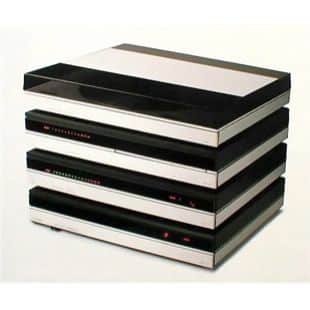
BeoSystem 5000
In the decade between 1970 and 1980 Japanese manufacturers were on the war path and the Bang & Olufsen board of directors was sweating. The popular trend was to stack components on top of each other in a rack, but the strategy adopted by Beosystem 5000’s designer – Jacob Jensen – was different altogether. Jacob […]
Overview
In the decade between 1970 and 1980 Japanese manufacturers were on the war path and the Bang & Olufsen board of directors was sweating. The popular trend was to stack components on top of each other in a rack, but the strategy adopted by Beosystem 5000’s designer – Jacob Jensen – was different altogether.
Jacob felt that the Japanese ideas were a mistake and spoke to B&O Board of Directors out loud, after which he jumped up and down on the stack of models he had designed. He looked at the group of 10-15 businessmen, now wide awake and expected a reaction but no one said anything except the economy executive Poul Skifter: “Well, we would like a note of credit for those models”.
The Japanese direction was abandoned. Later a compromise was made called Beosystem 5000, a B&O rack, which was named “The Best of Two Worlds”.
Beosystem 5000 was the first series of components from Bang and Olufsen in many years which returned to a ‘box’ design. The original units in the system were the Beomaster 5000, Beocord 5000, Beogram 5000 (Record Deck) – (and later in production the Beogram 5005 Record Deck), a two-way remote control unit unique to the 5000 system – the Master Control Panel 5000, a one-way hand-held remote control and a wide selection of Beolink® possibilities which could allow the 5000 to be operated from any room in a home, office or building. Beogram CD50 was later added to the System for playing compact discs.
Long, medium and FM wavebands were featured on this high-technology 2 x 55 watts receiver that served as the heart of Beosystem 5000 introduced in 1983 – the Beomaster 5000. A frequency synthesized tuner with automatic fine tuning and two-speed manual drive all contributed to fast, accurate location of radio programmes and superb reception quality. Nine station frequencies (on any combination of wavebands) could be stored in the Beomaster’s microcomputer memory for instant recall.
The low-distortion stereo amplifier included a very advanced feature, unique to Bang & Olufsen: Automatic Power Handling Control. This special circuit continuously monitored the dynamic range and power of the signal and instructed the microcomputer to decrease volume if the combined effects of these two parameters threatened to cause amplifier “clipping” or damage the speakers. This type of overload became increasingly common since the introduction of Compact Disc, which produces signals of enormous dynamic range, but it did not occur in the Beomaster 5000.
An internal, variable-speed fan ensured the proper dissipation of heat, even when the Beomaster is used in a stack format.
Beomaster 5000 had no visible controls. Normal operation was by means of the master Control Panel – a slim, table-top keypad that gave chair-side access to all functions including microcomputer programming and storage, timer facilities, status check, day and clock display, volume, tone and stereo balance adjustments and control of all sound sources. A programme-sequencing facility allowed you to pre-plan a whole evening’s listening composed of record, radio and cassette music in any order and combination. Once set, this “command performance” could play continuously as instructed without further use of the controls.
Direct operation of all primary functions was available on the Beomaster itself should the master Control Panel not be to hand. These controls were located beneath a hinged cover which sprang open at a touch. A separate, small Terminal – Terminal 5000 – was also available as an accessory to control Beomaster’s main functions.
The recommended speakers to complete Beosystem 5000 were Beovox S55. An ideal bookshelf speaker, Beovox S 55 could also be used as a wall-mounting speaker or free-standing model with the optional fittings available separately. The pressure cabinet contains an 22cm bass driver, an 11cm mid-range/phase-link unit and a 2,5cm tweeter. Power handling was 55 watts RMS.
If you crave maximum audio-visual performance for your hard-earned cash, there’s only one route to take: go for separates. Buying separate audio and AV components means you cherry-pick the very best in each category. What’s more, beefier (with individual power supplies), selected components plus better screening against interference inevitably deliver a higher standard of baseline performance.
Alright, they usually take up more space, but separates-based audio and AV systems are much more interference-resilient and offer vastly more potential for future expansion – an important advantage in the fast-changing world of hi-fi, video and home cinema. The only real downer is that you have to sift through hundreds of components in order to find the gems but if its sound and performance you’re after, there’s only one way to go!
Product Details
Software
No software information available.
Product Specification
No specifications provided.
System Items
| Title | Categories | View |
|---|
Photo Gallery
No gallery images.
Frequently Asked Questions
No FAQs available.






